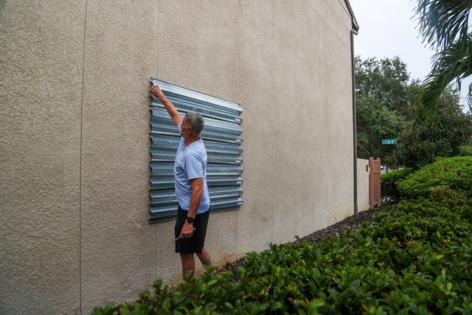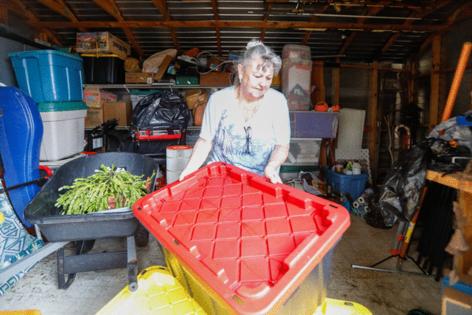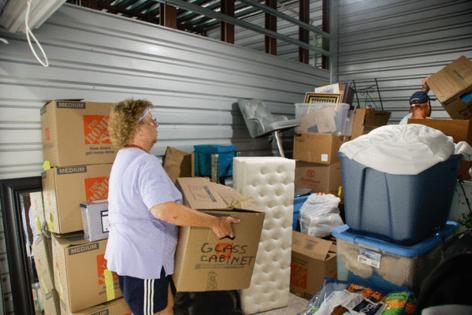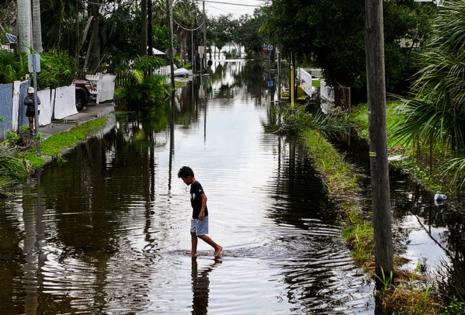13 days, 2 hurricanes, and incalculable anxiety in Tampa Bay
Published in News & Features
TAMPA, Fla. — We were still mucking the floors and ripping out drywall when we saw the first forecast.
The National Hurricane Center released the graphic, an ugly white blob over the Gulf of Mexico, at 11 a.m. last Saturday. It reached us via texts from our cousins and alerts from the local news or guys showing us their phone screen in line at Publix.
Hurricane Helene had lashed Tampa Bay eight days earlier. You could hardly turn down a street without seeing busted-up dressers and sodden couches on the curb. We were still learning about more than a dozen neighbors the storm killed in Tampa Bay, many of whom drowned in their homes. We were still gaping at photos of sand piled like snowdrifts on beach streets, still donating to friends made homeless.
Now Milton was on the way.
There went its track, straight into Tampa Bay. We scoffed. We joked in group texts, laughing to keep from crying.
Where are we moving to? Michigan maybe? What disasters do they have there? Someone shared a Zillow listing for a big house near Cincinnati, cheaper than anything you’d find here. Were we still joking?
Hurricanes are part of the price we pay to live on a “peninsula in the tropics,” as Florida’s emergency management director described the state this week. We get 200-plus days of annual sunshine, cotton-candy sunsets and sweet tropical fruit in our backyards. We also face the occasional threat of annihilation.
Longtime residents know the routine when it comes to hurricanes and, after the past two weeks, so do the many transplants who have moved to a part of the state that was affected, which is pretty much all of it.
Hurricanes get measured with precision: maximum winds and pressures; the historic, life-taking surge of Helene; the once-in-1,000-year deluge of Milton. While we can’t measure Floridians’ collective stress and exhaustion like rainfall, we sense that these last two storms set a record for that, too.
As Milton approached, we emptied our refrigerators, which we’d just restocked, into coolers with ice. We sipped from bottles of High Life — might as well — and heated remnants of half-eaten pizzas to make room as we prepared to run. Then we shut off our electrical breakers and locked up our houses in the dark.
We traveled in cars packed with unhappy pets and photo albums and favorite pillows. Friends sent pictures of bare store shelves. Our out-of-state family who knew nothing about hurricanes texted well-meaning and useless pieces of information. We tried not to hold it against them.
We fanned out across Florida wondering, as the track wobbled, whether we’d picked a safe spot. With around half a million people under mandatory evacuation orders, our cars clogged Interstate 4 and Interstate 75, and our bodies filled up all the Airbnbs, VRBOs, motels and hotels. In lobbies, we traded stories — our origins, our zones, our fears. Good luck to you.
Many flocked to the center of our state, a “magical” place with more hotel rooms than most cities on earth. The tourists from Indiana with Mickey shirts wanted to hear what we, the apparent experts, thought about Milton. We were busy on our phones, hunting for rooms for friends and family who had waited to make plans. We called hotels for them to ask, “Is your building pre-Andrew?” and the clerks knew what we meant.
Those who weren’t evacuating went to Home Depot for plywood, where forward-thinking handymen passed out their business cards.
We forgot things. At a Walgreens, hours before the weather was set to worsen, a manager held the entrance closed as more than 100 customers clutched toilet paper and water and stragglers kept trying to push inside. The 911 dispatchers showed up to the office carrying duffels, knowing they’d be sleeping at work.
Round-the-clock storm coverage held us in its hypnotic glow. The public officials on TV had traded their suits for windbreakers and ball caps. The linemen were staging, they said. The forecasts were dire.
We typed out comments beneath forecasts, enshrining our anxiety.
This is the first time in a long time that I am very, very worried and scared. I truly feel like life is going to change.
We waited.
The fear ran deeper this time, nipping at the heels of Tampa Bay’s worst storm in a century. Our chests ached as dark daydreams crept into those long, long hours. Where would it go? And how could we possibly take any more?
Milton made landfall just after 8:30 p.m. on Wednesday near Siesta Key under cover of darkness — just 13 days after Helene. The worst always seems to come when we should be asleep.
We opened our front doors and stepped out to feel the rain. After days of watching a red and purple radar mass haunt our screens, we had to see Milton in person. But as Wednesday night became Thursday morning, it was the sound — wind like thunder shaking our walls — that terrified us. We prayed that our roofs didn’t fly off.
That storm was the most scared I’ve been since I was a kid.
Police and firefighters had already stopped responding to calls, for their own safety.
An opposing stream of strong, dry wind shear — “westerly flow aloft,” the meteorologists called it — weakened and wobbled Milton just far enough to the south to spare Tampa Bay from catastrophic storm surge, but there were few other bright spots. The storm poured out record amounts of water around Hillsborough and Pinellas counties, in some places more than 15 inches in only a few hours, creating a flash flood emergency. The storm lost half its formation on radar, but we saw what even a sloppy hurricane could do.
As the sun rose, it shone down onto the diamond of an exposed Tropicana Field. It wasn’t long before people were selling pieces of its shredded fabric roof on eBay. Blocks away, with terrifying weight, an immense crane constructing a gleaming new skyscraper had smashed through several floors of a downtown office building, one of the city’s oldest.
Three million households found themselves without electricity. We who had stayed stepped outside to walk our sorry blocks, finding live oaks crushing roofs, telephone lines like torn streamers. We saw apartment buildings missing entire outer walls, houses in ashes. We who had fled begged neighbors to drop by our homes. On Reddit and Facebook and Nextdoor, we commented in the hundreds: Could you check out 4137, the house with the blue door?
Slowly reports trickled in about the catastrophic flooding in neighborhoods no one had expected, and the residents ferried to safety on inflatable boats, including what the Pinellas County Sheriff called “the most significant water rescue” ever in the county — hundreds of people pulled from an apartment complex. We are still learning the extent of the flooding and damage across the region.
We mourned our little neighborhood spots, like the flooded obscure Tampa mini-mart with the great boiled peanuts, just as much as the regional icons like the MidFlorida Credit Union Amphitheatre, where a section of roof flew away.
Milton, like all hurricanes, doled out suffering on an unfair spectrum. We all agonized. But some of us were merely left sweating through a long power outage with spotty phone service, while others, in floods and fires, lost everything they hadn’t taken along.
Across the state, at least 23 lost their lives in more than a dozen counties, at least six from tornadoes. Others were killed by falling trees or electricity. A woman died in a crash at a Tampa intersection with dead stoplights. An evacuee suffered a stress-related heart attack in an Orange County hotel room.
We emptied our accounts and racked up credit card debt on supplies and hotels, but other bills remained due. We still had weddings to pay for, funerals to plan, dogs bound for the vet, demanding bosses, cranky kids, papers to write. We spent the money we had been saving to move out of our in-laws’ place.
Life went on. Two women gave birth in hurricane shelters.
After the storms, we were merely human. We argued in grocery stores over the last rotisserie chicken and over cutting the line for the pump at the one Wawa with gas, which we needed to un-evacuate, but also to fuel our generators if we were lucky enough to have them. We gave up on finding ice but idled in lines literally a mile long at filling stations we’d found on the GasBuddy app, with plenty of time to ponder how quickly things can look apocalyptic despite all our modern comforts.
I’m trying so hard not to panic.
We helped our neighbors move trees, gave them cases of water and handheld fans and searched for their missing cats. I have a propane mini grill. I have a battery-powered chainsaw. Anyone need three bags of ice? We commiserated. In some cases, we caught up after years, or met for the first time. The weather was beautiful.
Some of us swore we’d leave the state, but others resolved to stay. Some felt like coming so close to losing our piece of this place crystallized our hopeless love for it.
We pondered how these storms felt somehow unprecedented, even in this storm-battered state. In such a short time, in vastly different ways, Helene and Milton flooded unexpected places once thought safe. Some of us remembered, exactly 20 years ago, the season of Charley, Ivan, Frances and Jeanne — six weeks, four hurricanes. And yet these latest storms were different.
What has changed, meteorologists say, is the speed and intensity with which hurricanes can strengthen due to climate change.
We weighed this feeling of unpredictability alongside the most accurate forecasts in history, grappling with the fact that there is “no guaranteed 100% safe place in or around a hurricane,” as retired forecaster Dennis Feltgen put it.
We hid from the wind, ran from the water, but it found us anyway.
Feltgen grew up here, spent 50 years as a meteorologist, 15 years as a spokesperson for the National Hurricane Center in Miami, then retired to Minnesota — no more hurricanes.
He remembers doing stories every year in the 1980s and 1990s when he was on local TV in Tampa, about the catastrophe it seemed the city was overdue for. Tampa still has not suffered a direct hit in 100 years. It will happen, Feltgen said.
Storms have shaped Florida’s coast for eons. The weather happens on a timeline greater than human memory. But in our lifetimes, the one-two punch of 2024 will be hard to forget.
On the Saturday two days after Milton, sawdust flew under a gentle sky as we cut through fallen palms and stowed the plywood shutters. We stared at the estimates the power company sent, promises that the lights would come back on. We left our key cards at the front desk, prayed for open roads and began the drive home.
©2024 Tampa Bay Times. Visit tampabay.com. Distributed by Tribune Content Agency, LLC.














Comments